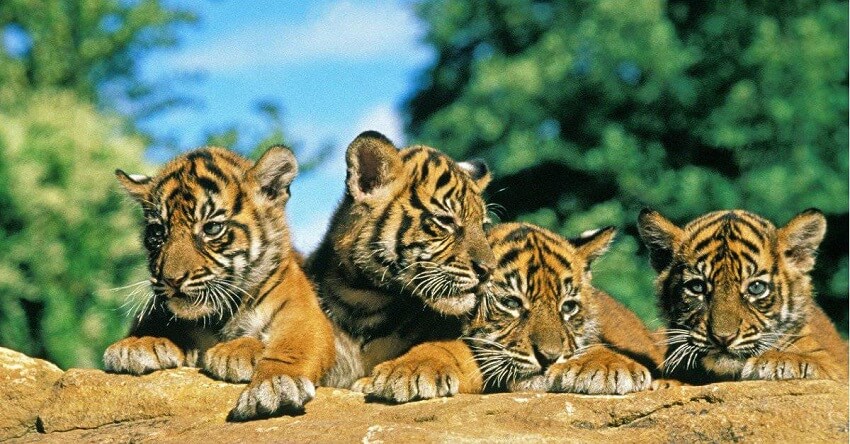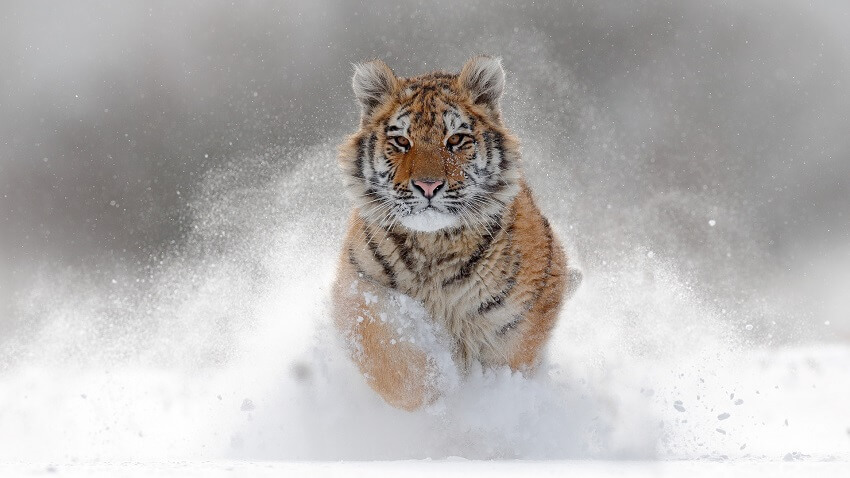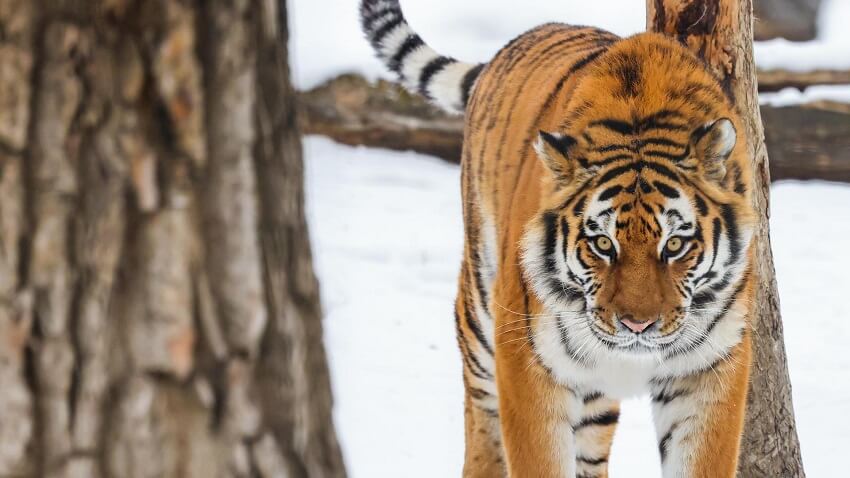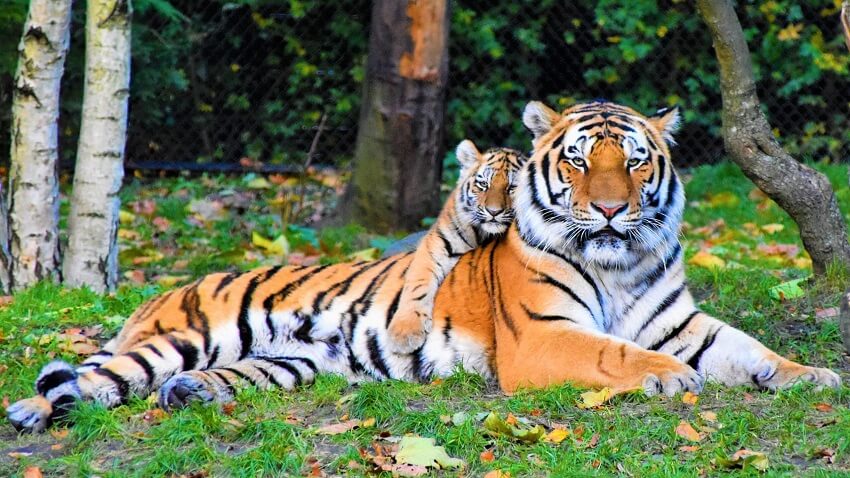Tigers are considered sacred animals in the cultures and religions of some East Asian countries. In Vietnamese culture, the tiger is seen as a symbol of strength, courage, and loyalty. Join KnowAllAnimals to explore some information about this animal and find out What’s the Biggest Tiger Species in the following article. Let’s go!
1. Introduction to Tigers
- Kingdom: Animalia
- Phylum: Chordata
- Class: Mammalia
- Order: Carnivora
- Suborder: Feliformia
- Family: Felidae
- Subfamily: Pantherinae
- Genus: Panthera
- Species: P. tigris
The tiger, with the scientific name Panthera tigris, is the largest animal in the cat family (Felidae). In local dialects, tigers are also called cọp, hùm, kễnh, or “lord of the jungle.” In terms of size, the tiger is the third-largest terrestrial carnivore in the world, surpassed only by the polar bear and brown bear.
Tigers’ habitats are dense forests or large grasslands, where they can easily camouflage themselves to hunt or hide from predators. Tigers are very good climbers, second only to domestic cats, but they are also very strong swimmers.
In the wild, tigers are solitary animals and only pair up during the mating season. They are the top predator in the food chain. All animals can be a tiger’s prey, mainly medium-sized animals like deer, buffalo, and cattle, down to small animals like rabbits, chickens, and ducks. Large animals like elephants can also become a tiger’s prey under special circumstances.
Currently, tigers live and are distributed in Asian countries such as Russia, China, India, Vietnam, Iran, Malaysia, Laos, Cambodia, and Thailand. In Vietnam, the number of tigers is on a rapid decline, and they only live in remote forest areas on the border of Vietnam and Laos, in Nghệ An, and in Lâm Đồng.
In the last century, the number of tigers worldwide has rapidly decreased due to illegal hunting. Tigers are hunted mainly for their skin, fur, teeth, bones, and other body parts. It is estimated that there are only about 200 wild tigers left in Vietnam.

2. Biological Characteristics of Tigers
Let’s learn about the characteristics of tigers with the following information:
2.1. Size
There are many tiger species around the world, and their sizes vary depending on their geographical location and climate. On average, a male tiger is between 2.6 and 3.3 meters long and weighs from 150 to 360 kg. A female tiger is, on average, 2.3 to 2.75 meters long and weighs between 100 and 160 kg.
The largest tiger species in the world is the Siberian Tiger, which can reach up to 3.5 meters in length and weigh up to 360 kg. The smallest tiger species in the world is the Sumatran Tiger, which is about 2.6 meters long and weighs between 75 to 140 kg on average.
Tigers generally have long, slender bodies that make it easy for them to move and hunt.

2.2. Color
Most tiger species have a yellow coat with black and white stripes on their chest, tail, legs, and neck. The yellow color can vary from dark yellow to orange and even reddish tones. Many other coat color variations have also been recorded, such as:
- White Tiger: Has black and white stripes. These are rare individuals that have a recessive gene, and they are not albinos.
- Golden Tiger: The fur is a lighter yellow than that of a regular tiger, and the black stripes are brown.
- Black Tiger: The body is pigmented from its habitat, and the fur gradually turns black to adapt.
2.3. Biological Behavior
Tigers are solitary animals. Each tiger has its own territory, which can extend up to 160 km. They only meet and live together during the mating season, which lasts from February to November each year.
The mating period for a male and female tiger can last from 5-7 days, with mating occurring 2-3 times a day and each session lasting no more than 1 minute. When the female tiger has successfully conceived, she will growl and chase the male away.
The average gestation period for a female tiger is 105 days, and she gives birth to an average of two cubs. In some cases, she can give birth to 1-5 cubs. The survival rate of cubs is quite low. Therefore, the mother tiger will care for and nurture them until they are mature, which is usually at three years of age.
In rare cases, male tigers, female tigers, and their cubs live together in a pack.
2.4. Tiger Classification
In the wild, nine different tiger species have been documented, three of which are now extinct:
- Bali Tiger – Panthera tigris balica
- Javan Tiger – Panthera tigris sondaica
- Caspian Tiger – Panthera tigris virgata
The remaining tiger species, listed in order of increasing population, are:
- South China Tiger – Panthera tigris amoyensis: There are currently about 59 individuals in captivity.
- Sumatran Tiger – Panthera tigris sumatrae: There are still about 500 individuals, living on the island of Sumatra, Indonesia.
- Siberian Tiger – Panthera tigris altaica: They mainly live in eastern Russia, with a population of about 540 individuals.
- Malayan Tiger – Panthera tigris jacksoni: Lives in the southern part of the Malay Peninsula with a population of 600-800 individuals.
- Indochinese Tiger – Panthera tigris corbetti: Found in Indochinese countries, Thailand, Malaysia, Myanmar, and Southern China. The population is about 1,200-1,800.
- Bengal Tiger – Panthera tigris tigris: Found in South Asia, including India, China, Bhutan, Bangladesh, and Nepal. The wild population is estimated to be 2,000.

3. What’s the Biggest Tiger Species?
As we know, the largest tiger individuals reach a maximum weight of 360 kg (794 lbs). However, with advances in modern science, scientists have created the biggest tiger species in the world: The Liger.
A Liger is a crossbreed between a lion and a tiger. Because it’s a hybrid, it inherits all the dominant traits of both species, and a Liger’s weight can reach up to 400 kg (882 lbs).
Since the habitats of their parent species are quite different, all Ligers currently exist in captivity. The record for the largest tiger in the world belongs to an 18-year-old Liger living at the Bloemfontein Zoo in South Africa, which weighed up to 798 kg (1,760 lbs).

4. Tiger Conservation
Although considered a fierce predator, the tiger population is rapidly declining. Statistics show that as of 2016, the global wild tiger population was only about 3,890 individuals.
The main threats to the tiger population are habitat destruction due to human activity, as well as increasingly sophisticated and complex illegal wildlife trade. Tigers are hunted for their fur, meat, bones, and other parts, which are used in traditional medicine.
As a result, this animal has been listed as a threatened species by the IUCN. Conservation efforts have been implemented to help the population grow. In India, in particular—the country with the largest number of tigers in the world—strong action has been taken, leading to a 30% increase in the number of tigers there in 2016 compared to 2011.
The protection of tigers and other wildlife needs to be emphasized so they can thrive and not face the risk of extinction. According to statistics, the cost of funding for wildlife conservation projects from 2010 to 2016 was about 1.3 billion USD.
We hope these interesting facts about tigers have provided you with more useful knowledge. The tiger is a rare animal and is at risk of extinction in the wild, so we must act to protect them.

5. FAQs
1. Which tiger subspecies is the largest today?
That would be the Siberian (Amur) tiger—it can reach a length of up to 3.5 m (11.5 ft) and weigh up to 360 kg (794 lbs), making it the largest tiger subspecies on the planet that is still in existence.
2. Which subspecies is the smallest tiger in the world, and what is its size?
The Sumatran tiger is the smallest tiger subspecies, measuring about 2.6 m (8.5 ft) in length and weighing between 75 to 140 kg (165-309 lbs) on average.
3. What is a Liger, and what is its size?
A Liger is a hybrid of a lion and a tiger, which can reach a weight of up to 400 kg (882 lbs). The heaviest individual ever recorded was an 18-year-old Liger living in South Africa, which weighed up to 798 kg (1,760 lbs).
4. Which tiger subspecies are listed as critically endangered?
There are nine known tiger subspecies, of which the Bali, Javan, and Caspian Tigers are now extinct. The remaining subspecies—Siberian, Sumatran, Bengal, Indochinese, Malayan, and South China—are all seriously threatened.
5. What is the current status of the global wild tiger population?
As of 2016, the wild tiger population was estimated to be only about 3,890 individuals. This decline is mainly due to poaching, habitat loss, and illegal wildlife trade.
We hope that this article, “An Introduction to Tigers and What’s the Biggest Tiger Species?” from Know All Animals, has provided you with useful and interesting knowledge about tigers today. Thank you for reading our article.



